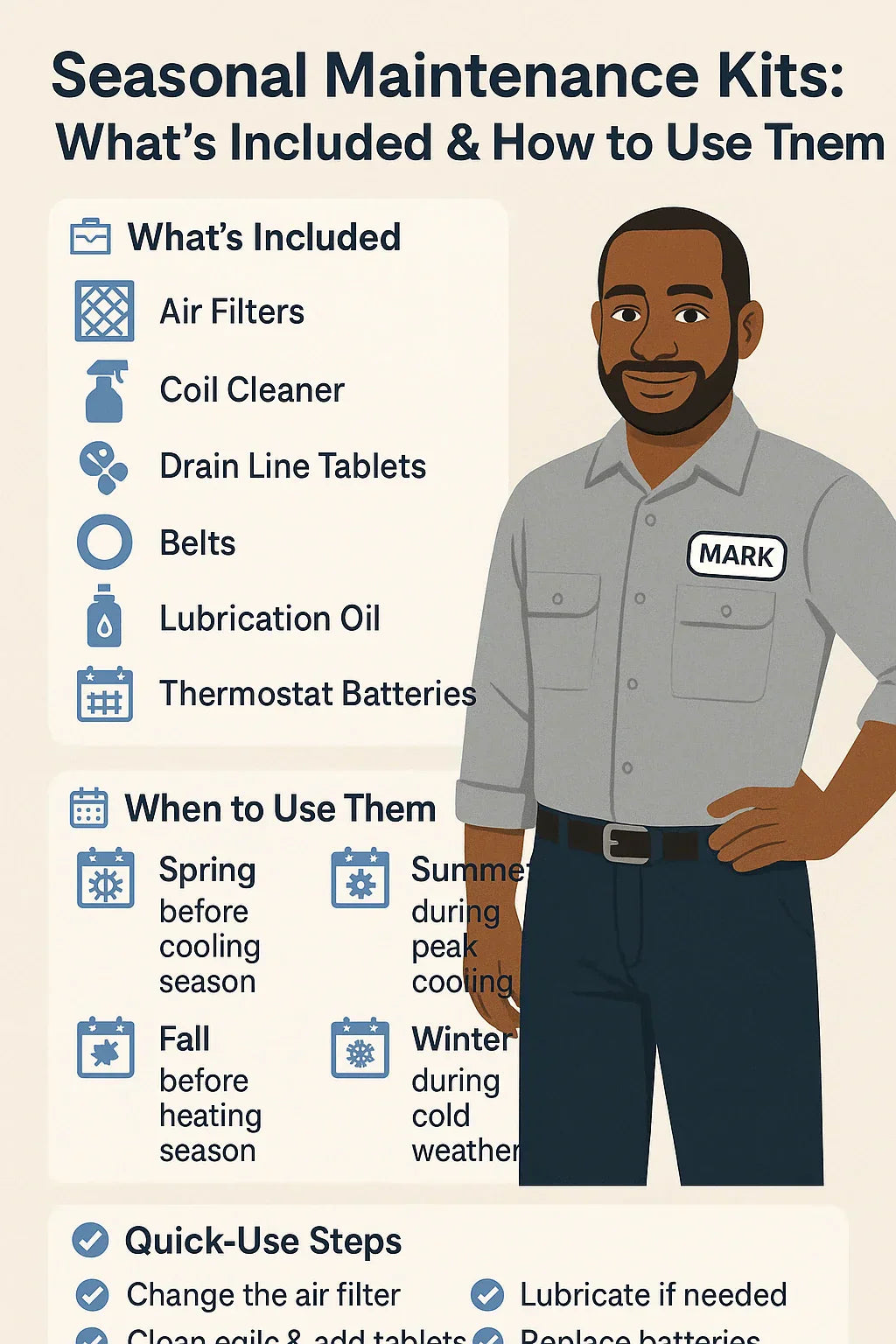By Mark — Your HVAC Guy Who Likes to Stay Ahead of Problems
Think of your HVAC system like a car: if you only drive it and never change the oil, replace the filters, or top off fluids, it won’t last long. The same goes for heating and cooling equipment.
That’s where seasonal maintenance kits come in. These pre-packed bundles give you the core items you need for a quick, effective tune-up—without making six trips to the hardware store.
In this guide, we’ll cover:
-
What’s inside a typical seasonal maintenance kit
-
When and how to use each item
-
Seasonal checklists for spring, summer, fall, and winter
-
Mistakes to avoid
-
How these kits save money in the long run
📦 1. What’s in a Seasonal Maintenance Kit?
While brands vary, most kits include:
-
Air filters — Keep dust, pollen, and debris out of the system
-
Coil cleaner — Removes dirt from evaporator and condenser coils for better airflow
-
Drain line tablets — Prevent algae buildup and clogs in condensate lines
-
Belts — Replacement for worn blower or fan belts in older systems
-
Lubrication oil — For certain older motors and bearings (newer sealed motors don’t need it)
-
Thermostat batteries — Keeps your thermostat working during power interruptions
-
Cleaning cloths or brushes — For wiping surfaces and removing debris
🧹 2. Air Filters: The First Line of Defense
Purpose:
-
Improve indoor air quality
-
Protect coils and blower from dust buildup
-
Maintain system efficiency
When to replace:
-
Every 1–3 months for standard 1" filters
-
Every 6–12 months for media or high-MERV filters
Mark’s Tip: Write the replacement date on the filter frame with a marker. Saves guesswork later.
🌀 3. Coil Cleaner: Restoring Airflow
Why clean coils?
-
Dirt and dust act like a blanket, forcing the system to work harder
-
Can increase energy usage by up to 30% if left dirty
How to use:
-
Shut off power to the unit
-
Spray coil cleaner evenly on the surface
-
Let sit per instructions (usually 5–10 minutes)
-
Rinse (for outdoor coils) or wipe (for indoor coils)
Safety note: Always wear gloves and eye protection.
💧 4. Drain Line Tablets: Stopping Algae Before It Starts
Purpose:
-
Prevents algae growth in condensate pans and lines
-
Reduces risk of water leaks and damage
How to use:
-
Drop one or two tablets into the condensate drain pan every 1–2 months during cooling season
Mark’s Note: This is a $2 fix that can prevent a $200 water damage repair.
🔧 5. Belts & Lubrication Oil
Belts:
-
Mostly found in older blower motors
-
Replace if cracked, frayed, or loose
Lubrication oil:
-
Only for motors with oil ports
-
Add a few drops every 6–12 months
Warning: Over-oiling can cause more problems than it solves.
🔋 6. Thermostat Batteries
Even hardwired thermostats may use batteries as backup. Dead batteries can cause system failure at the worst time.
When to replace:
-
Once a year (spring or fall)
-
Immediately if “low battery” warning appears
🗓 7. Seasonal Checklists
🌸 Spring (Cooling Prep)
-
Replace air filter
-
Clean condenser coil
-
Check refrigerant lines for insulation damage
-
Add drain line tablets
☀️ Summer (Peak Cooling)
-
Inspect and replace filter if needed
-
Check condensate drain for clogs
-
Monitor thermostat operation
🍂 Fall (Heating Prep)
-
Replace filter
-
Clean furnace burners (if safe to do so)
-
Inspect belts and lubricate if needed
❄️ Winter (Cold-Weather Efficiency)
-
Check filter monthly
-
Inspect exhaust flue for blockages
-
Ensure thermostat batteries are fresh
🚫 8. Common Mistakes to Avoid
-
Using the wrong coil cleaner — Acidic cleaners can damage aluminum fins
-
Skipping filter changes — Shortens system life and spikes energy use
-
Neglecting drain lines — Leads to surprise water leaks
-
Not checking compatibility — Belts and oil must match your system’s specs
💰 9. How Kits Save Money
-
Prevent costly repairs (average HVAC repair: $150–$450)
-
Lower monthly utility bills by keeping efficiency high
-
Extend equipment life (10–15 years vs. 7–10 with poor maintenance)
📌 10. Mark’s Seasonal Kit Quick-Use Guide
-
✅ Change the air filter first
-
✅ Clean coils while unit is off
-
✅ Add drain tablets
-
✅ Check belts/lubricate if applicable
-
✅ Replace thermostat batteries
-
✅ Wipe down accessible surfaces
🏁 11. Key Takeaways
-
Seasonal kits keep HVAC care simple and cost-effective
-
Each item plays a role in efficiency, safety, and longevity
-
A little DIY upkeep prevents big breakdowns
-
Following a seasonal schedule is the best way to get full system life
References
In the next topic we will read more about: What HVAC Accessories Do You Really Need? Mark’s Essential List for Homeowners







